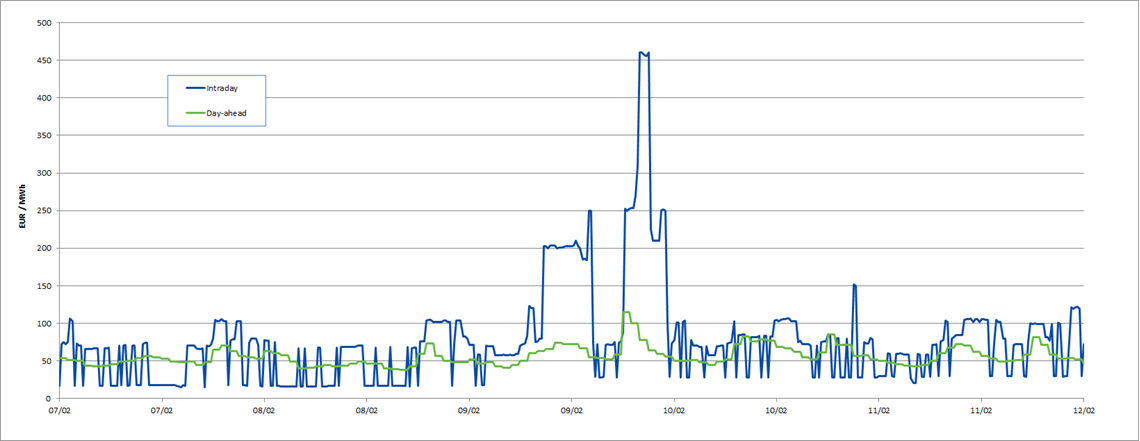Finesco specialises in 3 segments:
- Development and management of complex, bespoke energy projects in industrial environments
- Development, management and financing of energy projects for buildings or property portfolios
- The integration of renewable energy production into the energy markets
Finesco finances and realises various types of energy projects that reduce your overall energy cost and/or increase your income from your renewable energy production.
There are 3 types of projects:
- Energy efficiency projects that reduce your energy consumption.
- Local energy production that reduce the energy you draw from the grid and/or generate additional revenue.
- Flexibility projects to shift your consumption in time so that energy is drawn from the grid when it is cheaper or when less locally produced energy is injected into the grid.
Quite often, projects end up being a combination of two or three of the above types.
The ESCO approach
Finesco energy saving projects are based on the ESCO principle, which is summarised in the graph below:
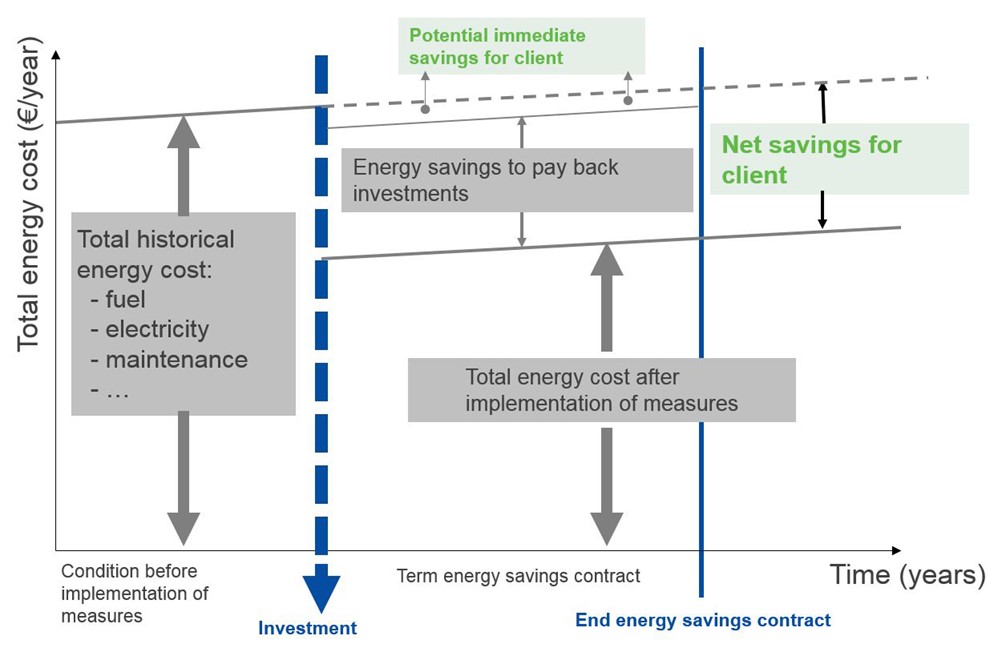
Typical Projects
Industrial cogeneration
Many companies need heat for their industrial processes. Examples of this are the food industry, the chemical and petrochemical industry and the paper industry. Depending on the temperature and pressure required, the heat is produced as (superheated) steam or hot water. Traditionally, this takes place in a gas-fired boiler with a typical efficiency of 90%. This means that 90% of the energy in the fuel is converted into useful heat.
In addition, the same companies use electricity, which they purchase from the grid and which is produced in power stations. Modern thermal power stations, combined cycles, have a typical efficiency of 55%. This means that 55% of the energy in the fuel (gas) is converted into electricity.
Combined heat and power (CHP), also called cogeneration, on the one hand produces the heat required and on the other hand at the same time produces local electricity. Its combined efficiency is typically more than 85%. This means that more than 85% of the energy in the fuel is converted into useful heat and electricity.
This is a much higher efficiency than the combined efficiency with separate generation of heat and electricity and consequently results in a global saving of primary energy (fuel) and therefore reduces CO2 emissions.
These figures are clearly shown in the diagram below – here a primary energy saving of 18% is obtained for cogeneration as compared to separate generation.
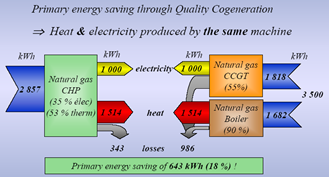
In addition to the CO2 reduction, which is beneficient for the environment, the financial advantage of cogeneration for the client is that cheap electricity is produced locally and this energy no longer has to be obtained from the grid. Moreover, the Belgian regions stimulate the use of CHP units by awarding CHP certificates according to the CO2 reduction or primary energy saving achieved. These CHP certificates have a value on the certificate market.
There are different kinds of CHP units. For larger capacities - above several MW electrical power- gas turbines and/or steam turbines are generally used. For smaller capacities - this may be just a few dozens of kW electrical power- the CHP unit generally consists of a gas motor. CHP units are therefore not only to be found in the industry, but can also be used for heating buildings.
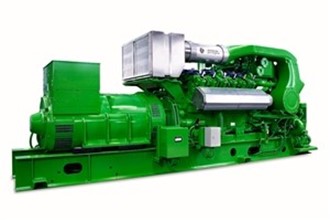
Our offer
Together with you, Finesco charts your heat requirements and then carries out a preliminary check to see whether a CHP unit could be interesting for you. If this is the case, we develop the solution together with an engineering partner, select the best supplier/installer for you, perform the necessary administrative formalities and follow up the project realisation. We pay for the investment and are paid back with the revenue generated by the installation. At the end of our contract, you become the owner of the CHP unit and can enjoy all the revenue from the installation
Organic Rankine Cycle (ORC)
In a number of companies, residual heat is available at a temperature between 100°C and 250°C . These temperatures are too low to produce electricity with steam by means of a traditional Rankine cycle. However, an organic Rankine cycle or ORC may provide a solution here. An ORC does not use water/steam as the working fluid, but an organic liquid with a lower boiling point than water. Moreover, in the vapour phase this liquid goes further into the superheated area when expanded in a turbine; this means that the vapour at the inlet of the turbine does not have to be superheated that much, making it possible to work at lower temperatures.
ORCs typically have an installed electrical power of several hundreds of kilowatts, but less or more is also possible, depending on the available residual heat .
Our offer
Together with you, Finesco determines the available residual heat in your process and its temperature. We are in contact with expert ORC companies allowing to submit a customised quotation. Finesco pays for the investment, signs the contracts, follows up the realisation and receives the revenues/savings during the operational phase obtained with the locally produced electricity. At the end of the contract, you become the owner of the whole ORC and can benefit from all the revenue.
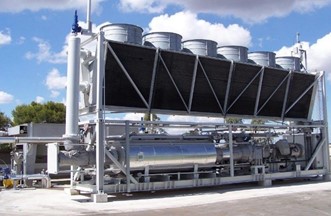
Integrated energy approach to buildings or building portfolios
Do you have an existing building or building portfolio with a gas or heating oil consumption of more than 1000 MWh per building per year, and/or an electricity consumption of more than 500 MWh per building per year? If so, Finesco would be happy to work out an integrated energy approach for your building(s).
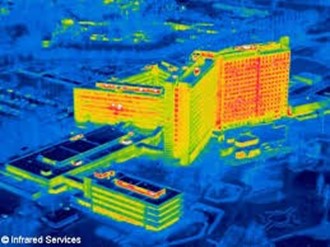
To do this, we look at a number of areas, including:
- Insulation: what are the possibilities of cavity wall insulation, facade insulation or roof insulation?
- Heating: what heating system is currently used? What fuel is used? How is the heating system controlled? We look at whether it is worth installing a new system and what the best solution is. For example, if you have an old heating system running on fuel oil, it may be worth switching to gas or to a combination of different solutions (e.g. including solar heating).
- CHP: is the addition of a CHP unit or its incorporation in a new heating system an option? This depends on the volume and continuity of the heat demand and also on the electricity consumption.
- Ventilation and cooling: is ventilation present? Is this an approved system? The same for the cooling.
- Relighting: what kind of lighting is currently used and what are the burning hours on an annual basis? It is often possible to realise significant electricity savings by switching to LED bulbs.
- Photovoltaic solar panels: do you have a large roof area available? Solar panels have fallen considerably in price in recent years and significantly reduce the electricity you take from the grid. It’s worth taking a look at.
Together with you we decide on the best combination of measures to be used. Finesco pays for the investment, follows up the implementation and is paid back by the annual energy savings. At the end of the contract, all the savings are for you and your building portfolio has become more energy-efficient. This increases comfort for the users and certainly raises the value of your building(s)!
Concrete Projects
Replacing a low voltage connection by a medium voltage connection
Does your company use more than 100,000 kWh of electricity per year and is it connected to low voltage? Then it’s worth considering switching to a medium voltage connection using a medium voltage substation. This enables you to save on distribution costs.
What is a medium voltage substation?
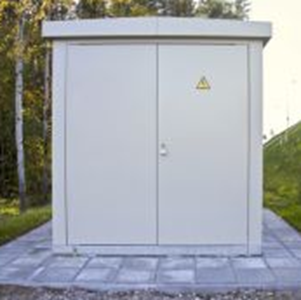
To limit losses on the electrical grid, the grid operators increase the voltage at which the electricity is transported. So, for example, the electricity on ELIA’s high voltage grid is transported at a voltage of 380,000 to 70,000 volts.
But the electrical supply of residential and industrial consumers operates at a voltage of only 400 or 230 volts. The distribution grid operators (EANDIS, INFRAX, SIBELGA, etc.) are therefore responsible for reducing the voltage just before the electricity is distributed to the consumers. This reduction takes place in medium voltage substations.
These substations may be owned by the distribution grid operator and installed on public land. Consumers are then directly supplied at a low voltage (400 or 230 volts). This solution is used for residential consumers and for companies with limited consumption.
But the substations may also be owned by a consumer or customer who is then directly connected to the medium voltage grid (from 10,000 to 24,000 volts).
A medium voltage substation consists of four elements :
The cells make the connection by means of switches on the loop of the distribution grid operator and contain a medium voltage output intended for the company connected to it.
The measuring cell enables the grid operator to install a meter for the energy used and/or injected.
The transformer reduces the medium voltage to low voltage.
The electrical installation can be disconnected from the company with the main fuse.
The grid operators have specific requirements for the installation of a medium voltage substation. The location must be directly accessible from the outside via a metal door and also should only contain electrical equipment. For this reason, a compact substation located outside is often a better solution.
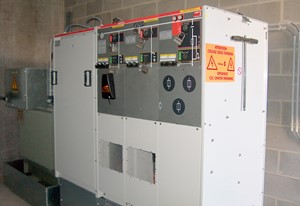
The savings
Companies that are connected to the medium voltage grid pay less distribution costs for their electricity than companies connected to low voltage. Companies with a low voltage connection use an extra part of the grid, namely the low voltage part, plus the medium voltage substation of the distribution grid operator. They have to pay for this, hence the higher cost.
Moreover, low voltage consumers generate more losses than consumers on medium voltage. This is due on the one hand to the larger transport losses on low voltage and on the other hand to the fact that the transformers of the distribution grid operators are becoming older and are therefore less efficient than modern transformers in a new medium voltage substation. This also contributes to the higher distribution cost for companies on low voltage.
Payback time
The payback time of a medium voltage substation varies according to your consumption, but from 100 000 kWh per year it is worth giving your specific situation careful consideration. To this end, the detailed investment cost must be determined as well as the exact savings depending on your consumption profile and distribution net tariffs.
Our offer
Finesco takes a look at your specific situation and works out a customised offer. Finesco also provides the financing. This means you don’t have to worry about anything and don’t have to lay out money on a new substation. For a number of years, part of the realised savings is used to pay back the investment. After the end of the contract, you become the owner of the medium voltage substation and can start to enjoy all the savings.
So you save from day 1 – and together with its partners Finesco takes care of everything for you:
- The design of the right solution
- The connection request to your distribution grid operator
- The building permit application if necessary
- The delivery and installation of the medium voltage substation
- The connection of the medium voltage substation to the grid
- The approval of the installation
- The maintenance
For more information, contact us on 056 36 44 00 or info@finesco.be.
Optimisation of your compressed air production
A significant volume of compressed air is required in the production process of many industrial companies. The pressure and flow depend on the specific situation. The compressed air is produced by one or more air compressors and distributed via a compressed air network to the machines that run on compressed air.
There are different types of compressors (screw compressors, turbo or centrifugal compressors, piston compressors, etc.) The driving unit is generally an electric motor - so electrical energy is converted into pressure energy. A study in a number of medium sized companies has shown that often much more electricity is used than technically necessary for the volume of useful compressed air produced.
There may be various reasons for this. The most obvious explanation is compressed air leaks, but the cause may also be an outdated control system or incorrect dimensioning. Moreover, the efficiency of certain types of compressors falls significantly as they grow older. So it is worth investing in new compressors.
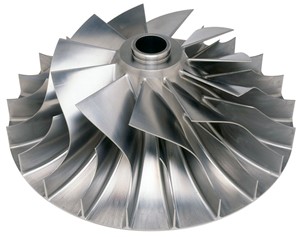
Our offer
Together with our expert partner, Finesco provides information on your compressed air system by means of a measuring campaign. Improvement measures are identified and, if investment is necessary, e.g. for new compressors, Finesco provides this. The investment can be paid back in two ways. The first way is based on the measured electricity savings and the second way means that you pay a price per consumed volume unit of compressed air.
In addition, together with you we select the optimal technical solution, work out an appropriate maintenance and operating schedule, enter into the necessary contracts with suppliers/installers and follow up on the project realisation.
In short, you don’t have to worry about anything, you realise savings immediately and don’t have to invest.
Flexible electricity production or consumption as revenue source
Does your installation offer a possibility to shift the time of your consumption? For example, by allowing your deep freezers or cold rooms to cool more for a period, and then to let them cool less for a period, so that even though the temperature does not remain 100% constant, it does stay within acceptable limits?
Or have you installed local electricity production on your site that can be interrupted, or even better, that is not active 100% of the time and for which you can choose when it operates, such as e.g. a landfill gas motor?
You then have an asset that can generate extra income on the electricity market. The price of electricity on the market fluctuates, i.e. according to the hour of production/consumption on a certain day. Moreover, these hourly prices also change over the course of the day itself on the Intraday market. Significant added value can therefore be realised by shifting local production or consumption
To realise this added value, a number of conditions have to be met:
- You need access to the Intraday market
- An intelligent algorithm determines the necessary transactions on the market with the corresponding technical interventions in your installation
- An automatic control system (or an operator) performs the technical interventions
Our offer
We look at your installation and together with you identify the potential for flexibility and the conditions required for this.
We give you access to the Intraday market via our sister company Elexys and together with Elexys estimate the value of the flexibility in your installation on an annual basis.
We pay for the required technical implementation.
The added value realised is calculated in a transparent manner and shared with you.
